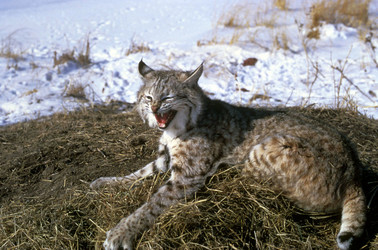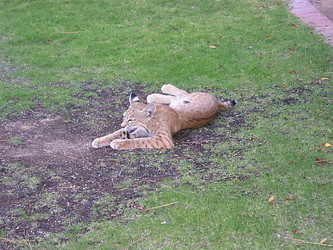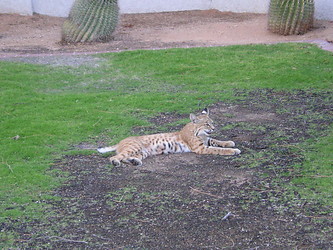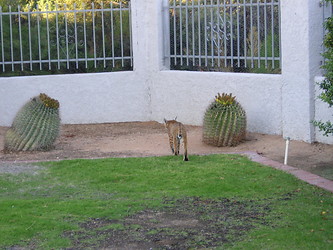| This page is about where bobcats live in the desert near Tucson, Arizona, and why they sometimes move into human settlements. Bobcats are nocturnal and like to be secluded from humans. This is getting harder for them because humans are destroying their habitat. Bobcats are very timid and like to avoid human contact. However, with humans destroying their habitat, contact between bobcats and humans is becoming more frequent. Bobcats are crepuscular, meaning that the bobcat becomes active near sunset and remains active until midnight or a few hours before sunrise, hunting while it is dark. The bobcat spends his day in a rocky crevice, a cave, or a thicket. Bobcats are very territorial, so the ranges of two bobcats can overlap to some degree, but two cats cannot live in the same exact area. A male bobcat's territory can overlap with the territory of up to five female bobcats. The area occupied by a bobcat can range from two square miles to forty square miles! Right now, bobcat numbers are declining drastically throughout the nation. In Arizona, the city of Tucson has expanded rapidly, leaving little space for the native species like the bobcat. New home building in bobcat territory the bobcat's timid nature combine to create a real problem for bobcat survival. Specifically, the bobcat is being threatened by lack of food and the decreasing size of its natural habitat. In the pictures below, this bobcat entered my backyard to catch a rabbit and rest in the grass. She later came back with her cubs and used our backyard as her habitat. At least one of her cubs still plays in our backyard on a regular basis (almost every morning). ConclusionIn order to protect the bobcat, we need to act now and make sure that there is enough space for the bobcat to survive before we build anymore houses or cut down any more trees. One measure already being taken to preserve the habitat of bobcats is to increase public knowledge. There are many nonprofit organizations devoted to protecting the bobcat and other big cat species. If you want to help with preserving the bobcat's natural habitat, you can donate to a nonprofit organization or try to make people aware about the problems the bobcat is facing due to new housing developments being built in bobcat territory.  Click on an image to view larger version & data in a new window  Lynx rufus. Photo by Conrad Fijetland, courtesy U.S. Fish and Wildlife Service Online Digital Media Library. This image shows a bobcat in the snow; bobcats have a wide geographical range - they are not just confined to the desert |  Lynx rufus. A bobcat in my Tucson, Arizona, backyard © 2005 butterfly1 |
 Lynx rufus. More lounging in my yard © 2005 butterfly1 | |
 Lynx rufus. Going back for the cubs? © 2005 butterfly1 |
Information on the Internet
- World Conservation Union: Cat Specialist Group This page contains information on bobcats in the Americas.
- DNR: The Bobcat This page from the US Fish and Wildlife Service is devoted to informing people about the bobcat.
- Bobcat This page is a quick guide and reference about the bobcat.



 Go to quick links
Go to quick search
Go to navigation for this section of the ToL site
Go to detailed links for the ToL site
Go to quick links
Go to quick search
Go to navigation for this section of the ToL site
Go to detailed links for the ToL site